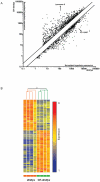Chronic hypoxia impairs muscle function in the Drosophila model of Duchenne's muscular dystrophy (DMD)
- PMID: 20975992
- PMCID: PMC2958114
- DOI: 10.1371/journal.pone.0013450
Chronic hypoxia impairs muscle function in the Drosophila model of Duchenne's muscular dystrophy (DMD)
Abstract
Duchenne's muscular dystrophy (DMD) is a severe progressive myopathy caused by mutations in the DMD gene leading to a deficiency of the dystrophin protein. Due to ongoing muscle necrosis in respiratory muscles late-stage DMD is associated with respiratory insufficiency and chronic hypoxia (CH). To understand the effects of CH on dystrophin-deficient muscle in vivo, we exposed the Drosophila model for DMD (dmDys) to CH during a 16-day ascent to the summit of Mount Denali/McKinley (6194 meters above sea level). Additionally, dmDys and wild type (WT) flies were also exposed to CH in laboratory simulations of high altitude hypoxia. Expression profiling was performed using Affymetrix GeneChips® and validated using qPCR. Hypoxic dmDys differentially expressed 1281 genes, whereas the hypoxic WT flies differentially expressed 56 genes. Interestingly, a number of genes (e.g. heat shock proteins) were discordantly regulated in response to CH between dmDys and WT. We tested the possibility that the disparate molecular responses of dystrophin-deficient tissues to CH could adversely affect muscle by performing functional assays in vivo. Normoxic and CH WT and dmDys flies were challenged with acute hypoxia and time-to-recover determined as well as subjected to climbing tests. Impaired performance was noted for CH-dmDys compared to normoxic dmDys or WT flies (rank order: Normoxic-WT ≈ CH-WT> Normoxic-dmDys> CH-dmDys). These data suggest that dystrophin-deficiency is associated with a disparate, pathological hypoxic stress response(s) and is more sensitive to hypoxia induced muscle dysfunction in vivo. We hypothesize that targeting/correcting the disparate molecular response(s) to hypoxia may offer a novel therapeutic strategy in DMD.
Conflict of interest statement
Figures






Similar articles
-
The X-linked Becker muscular dystrophy (bmx) mouse models Becker muscular dystrophy via deletion of murine dystrophin exons 45-47.J Cachexia Sarcopenia Muscle. 2023 Apr;14(2):940-954. doi: 10.1002/jcsm.13171. Epub 2023 Jan 11. J Cachexia Sarcopenia Muscle. 2023. PMID: 36628607 Free PMC article.
-
Alterations in Notch signalling in skeletal muscles from mdx and dko dystrophic mice and patients with Duchenne muscular dystrophy.Exp Physiol. 2014 Apr;99(4):675-87. doi: 10.1113/expphysiol.2013.077255. Epub 2014 Jan 17. Exp Physiol. 2014. PMID: 24443351
-
Respiratory Control in the mdx Mouse Model of Duchenne Muscular Dystrophy.Adv Exp Med Biol. 2015;860:239-44. doi: 10.1007/978-3-319-18440-1_27. Adv Exp Med Biol. 2015. PMID: 26303487
-
Harnessing the potential of dystrophin-related proteins for ameliorating Duchenne's muscular dystrophy.Acta Physiol Scand. 2001 Mar;171(3):349-58. doi: 10.1046/j.1365-201x.2001.00838.x. Acta Physiol Scand. 2001. PMID: 11412148 Review.
-
BREATHE DMD: boosting respiratory efficacy after therapeutic hypoxic episodes in Duchenne muscular dystrophy.J Physiol. 2024 Jul;602(14):3255-3272. doi: 10.1113/JP280280. Epub 2024 Jun 4. J Physiol. 2024. PMID: 38837229 Review.
Cited by
-
Muscle atrophy reversed by growth factor activation of satellite cells in a mouse muscle atrophy model.PLoS One. 2014 Jun 25;9(6):e100594. doi: 10.1371/journal.pone.0100594. eCollection 2014. PLoS One. 2014. PMID: 24963862 Free PMC article.
-
C-X-C motif chemokine ligand 12: a potential therapeutic target in Duchenne muscular dystrophy.Bioengineered. 2021 Dec;12(1):5428-5439. doi: 10.1080/21655979.2021.1967029. Bioengineered. 2021. PMID: 34424816 Free PMC article.
-
Impact of tRNA-induced proline-to-serine mistranslation on the transcriptome of Drosophila melanogaster.G3 (Bethesda). 2024 Sep 4;14(9):jkae151. doi: 10.1093/g3journal/jkae151. G3 (Bethesda). 2024. PMID: 38989890 Free PMC article.
-
Using Kepler for Tool Integration in Microarray Analysis Workflows.Procedia Comput Sci. 2014;29:2162-2167. doi: 10.1016/j.procs.2014.05.201. Procedia Comput Sci. 2014. PMID: 26605000 Free PMC article.
-
Induced Pluripotent Stem Cells derived Muscle Progenitors Effectively Mitigate Muscular Dystrophy through Restoring the Dystrophin Distribution.J Stem Cell Res Ther. 2016;6(10):1000361. doi: 10.4172/2157-7633.1000361. Epub 2016 Sep 26. J Stem Cell Res Ther. 2016. PMID: 28979820 Free PMC article.
References
-
- Engel AG, Franzini-Armstrong C. New York: McGraw-Hill; 1994. Myology.
-
- Hoffman EP, Brown RH, Kunkel LM. Dystrophin: the protein product of the Duchene muscular dystrophy locus. Cell. 1987;51:919–928. - PubMed
-
- Koenig M, Monaco AP, Kunkel LM. The complete sequence of dystrophin predicts a rod-shaped cytoskeletal protein. Cell. 1988;53:219–226. - PubMed
-
- Bach JR, Ishikawa Y, Kim H. Prevention of pulmonary morbidity for patients with Duchenne muscular dystrophy. Chest. 1997;112:1024–1028. - PubMed
-
- Inkley SR, Oldenburg FC, Vignos PJ., Jr Pulmonary function in Duchenne muscular dystrophy related to stage of disease. Am J Med. 1974;56:297–306. - PubMed
Publication types
MeSH terms
LinkOut - more resources
Full Text Sources
Other Literature Sources
Molecular Biology Databases

